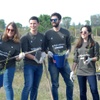IE University’s objective is to reduce greenhouse gas emissions to zero by 2030.
To reach our 2020 challenge, IE University focused on:
WATER. Reduce the use of plastic, single-use water bottles to promote responsible consumption. This affected the entire organization: staff, faculty and students. Drinking fountains were installed and actions were taken to promote the use of reusable containers.
PAPER. Reduce paper consumption. Among other related projects, IE University has been working for a decade to reduce paper consumption with projects such as WWF’s ‘100 Companies for the Forests’, where, every year, students replant trees in the Doñana National Park.
ENERGY. Reduce energy consumption on campus via lighting, air conditioning, etc. By 2030, our objective is to dramatically reduce our carbon footprint by becoming a zero-emission institution. In 2020, we focused on increasing our purchased renewable energy as part of our commitment to climate action with a goal for the implementation of ISO 50001 by the end of 2021.
PLASTICS AND SINGLE-USE PACKAGING. Build awareness to increase the use of recycled plastic or compostable PLA (derived from corn) on campus.
WASTE MANAGEMENT. We build awareness with campaigns about recycling in the institution. Implement ISO 14001.
TRANSPORT. Implement new formulas for sustainable movement of staff, teachers and students between campus buildings: car-pooling, electric shuttles and bicycle racks.



